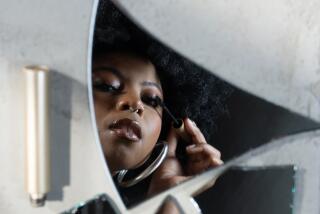Practical Applications From the Makeup Pros
- Share via
Dying to duplicate cover girl glamour? Good genes aren’t the only component. Makeup artists are largely responsible.
Though the average woman can’t afford a makeup artist on a regular basis, she might be able to spring for an entire wardrobe of makeup brushes similar to those used by the pros.
“Brushes simply enhance the makeup process and make application easier,” explains Jane McKay, director of technical training at M.A.C. Cosmetics, whose full 31-brush line is carried at Nordstrom. The store also stocks a line of Joan Simmons Japanese goat hair brushes. Nordstrom brushes range in price from $2.50 for a Simmons tool to $65 for an M.A.C. squirrel hair powder brush.
Brushes vary as much in quality and specific uses as they do in price. The most expensive tools are made of sable. Like those made of beaver, the animal must be skinned to obtain the material.
These days, socially correct cosmetic companies that offer makeup brushes are forgoing these materials in favor of more environmentally friendly--and cheaper--goat, tiger, camel and pony hair, which can be painlessly extracted from an animal’s tail.
Stiffness and shape determine the designated use of a brush and how it applies color. The shorter the brush hairs, the more concentrated the color will be, explains Jocelyn Zayco, makeup director for Trucco. Longer hairs maximize blending.
The “payoff”--or amount of color deposited--also differs depending on the shape of the brush’s tip. Some brushes have a flat edge--they will hold color on the tip of the brush and deposit color in a shape similar to the tip. Tapered brushes are better for contour jobs. Sponge applicators deposit heavy applications--but for colors to be really blended, brushes give you variation between sheer and dense.
Handles are also an important consideration. The longer the brush handle, the more comfortable the feel and the better the control. However, professional makeup artists agree that this is largely a matter of personal preference. Vision impairment can often facilitate the need for a shorter brush if you need to be close to a mirror.
Brushing Up on the Equipment Available
Here is an outline of a variety of makeup brushes available to novice and professional makeup artists:
* Blush brush: The bristles on this brush should be soft for maximum dusting and blending. Ideally, there should be an edge for contour to sculpt the cheekbone. The more tapered the edge, the easier it will be to apply color directly underneath a facial bone. This creates the much desired slimming contour. Round-shaped blush brushes (also used for powder) are ideal for creating the rounder cheek shape popular with younger girls desiring the au courant gamin look, most of whom have no need to contour sagging jawlines and double chins away.
* Powder brush: This brush, usually rounded at the tip, is ideal for lightly powdering face, neck or even body. Some people also use it to apply scented bath powder. Sizes vary based on personal preference.
* Shader brush: Most shader brushes are slightly rounded on top and straight on the side. They are ideal for precise applications of eye shadow, lipstick and concealer. Rounded edges allow for natural strokes.
* Eyeliner brush: Though many women use automatic liner pens, there are some who use this moistened brush and apply it to a cake eyeliner product or to cake eye shadow.
* Lip brush: Shapes range from pointed to flat. These brushes are ideal for filling in lined lips, and are perfect for creating matte lip looks. Women who use lip brushes rarely have to blot their lips after applying color and many find it lasts longer when applied this way, Zayco says. Some of these brushes are capped or retractable. A brush that is soft to the touch and still controls its shape, McKay says, is superior for controlling the application.
* Angled brush: The brush is invaluable when applying a thin line of color to the eyelid, or when applying “dry eyeliner” applications, or powder in lieu of wet liners. It is also handy for eyebrows, and some people will even use this brush for a wet eyeliner application to create a thicker line.
* Fluff brush: This brush helps women smooth any harsh lines between colors in eye shadow, cheek contours and blush application. These tools blend the colors to achieve a more natural look. Depending on the area to be blended, this brush may be as narrow as the width of a pinky finger to as wide as a blush brush.
* Lash brush: This tool, which is essentially the tip of a mascara wand, works to separate eyelashes before and after mascara application. It is also used to groom eyebrows, or to add or even out an application of pencil or shadow.
* Crease brush: Women who want to strategically place shadow in the crease of their eyelid will find this tool invaluable. This brush features a tapered edge. The tip is easily manipulated to pick up and deposit color into the crease of the eye.
Caring for Your Brushes
A set of brushes will last indefinitely if cared for. Some maintenance is required to ensure their longevity.
The Simmons brushes at Nordstrom offer a lifetime guarantee.
M.A.C. Cosmetics’ Brush Cleanser will do the trick, but the most important part of cleaning brushes involves reshaping them into their intended flat edge or tip, the same way a person combs wet hair after a shampoo.
McKay recommends users clean their equipment at least once a week or more.
Once clean and reshaped, McKay suggests placing them over the free edge of a table or ledge for faster drying.






